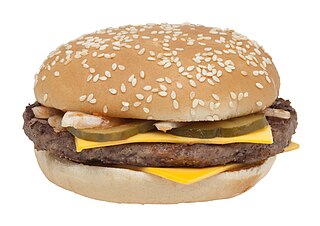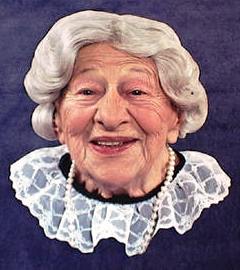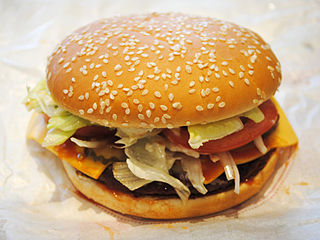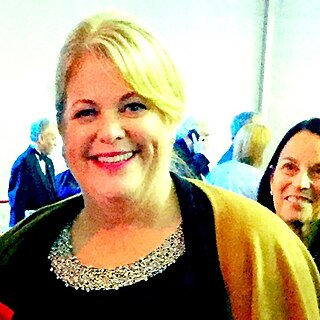
"Where's the beef?" is a catchphrase in the United States and Canada, introduced as a slogan for the fast food chain Wendy's in 1984. Since then it has become an all-purpose phrase questioning the substance of an idea, event, or product. [1]

"Where's the beef?" is a catchphrase in the United States and Canada, introduced as a slogan for the fast food chain Wendy's in 1984. Since then it has become an all-purpose phrase questioning the substance of an idea, event, or product. [1]

The phrase first came to the public audience in a U.S. television commercial for the Wendy's chain of hamburger restaurants in 1984. The strategy behind the campaign was to distinguish competitors' (McDonald's and Burger King) big name hamburgers (Big Mac and Whopper respectively) from Wendy's "modest" Single by focusing on the large bun used by the competitors and the larger beef patty in Wendy's hamburger. In the ad, titled "Fluffy Bun", actress Clara Peller receives a burger with a massive bun but a tiny patty from a fictional competitor, which uses the slogan "Home of the Big Bun". The small patty prompts Peller angrily to exclaim, "Where's the beef?" Director Joe Sedelmaier actually wanted Peller to say, "Where is all the beef?" but because of emphysema, that was too hard for her. [2]
The commercial was originally supposed to star a young couple, but Sedelmaier did not find the concept funny and changed it to the elderly ladies. [2]
An earlier version, featuring a middle-aged bald man saying, "Thanks, but where's the beef?", failed to make much impact. After the Peller version, the catchphrase was repeated in television shows, films, magazines, and other media outlets.
First airing in 1984, the original commercial featured three elderly ladies at the "Home of the Big Bun" examining an exaggeratedly large hamburger bun. The other two ladies poke at it, exchanging bemused comments ("It certainly is a big bun. It's a very big bun. It's a big fluffy bun. It's a very big fluffy—"). As one of the ladies lifts the top half of the bun, a comically minuscule hamburger patty with cheese and a pickle is revealed (prompting her to finish the sentence "—bun." with a much more disappointed tone). Peller immediately responds with her outraged, irascible question. [3]
Sequels featured Peller yelling at a Fluffy Bun executive from his yacht over the phone and approaching fast food drive-up windows (including the "Home of the Big Bun" and a restaurant with a golden arch) that were slammed down before she could complete the line.
Later in 1984, Nashville songwriter and DJ Coyote McCloud wrote and performed a hit song entitled "Where's the Beef?" as a promotion for Wendy's restaurants' famous advertising campaign featuring Clara Peller. [4]
The advertising campaign ended in 1985 after Peller performed in a commercial for Prego pasta sauce, saying "I found it, I really found it", [5] a phrase alluding to the beef in the listener's mind.
There were many "Where's the beef?" promotional items, including bumper stickers, frisbees, clothing patches, a Milton Bradley game, [6] and more.
In 2011, Wendy's revived the phrase for its new ad campaign, finally answering its own question with "Here's the beef". [7]
During the COVID-19 pandemic in the United States in 2020, when stores were experiencing a shortage of beef, Wendy's revived the ad. [8]
To launch their new breakfast menu in Canada, Wendy's released a new advertisement campaign called "Where's the Bacon?" as a callback to the "Where's the Beef?". The new campaign is similar to its older counterpart, except it focuses on the amount of bacon in breakfast sandwiches rather than beef size. [9]
For the 2023 Daytona 500, Legacy Motor Club driver Noah Gragson, sponsored by Wendy's, uses the No. 42 Chevrolet Camaro carrying "The Beef" on the hood, and a video released by the team featured Gragson using the phrase in the promotional video. [10]
William Welter, the executive vice president of Wendy's International, led the marketing team at the time of the campaign. [11] The commercial was directed by Joe Sedelmaier as part of a campaign by the advertising agency Dancer Fitzgerald Sample. It was written by Cliff Freeman. The marketing and promotion campaign were created by Alan Hilburg and the Burson-Marsteller team under the direction of Denny Lynch, the vice president of corporate communications at Wendy's.
The phrase became associated with the 1984 United States presidential election. During primaries in the spring of 1984, when the commercial was at its height of popularity, Democratic candidate and former Vice President Walter Mondale used the phrase to sum up his arguments that program policies championed by his rival, Senator Gary Hart, were insubstantial, beginning with a March 11, 1984, televised debate at the Fox Theatre in Atlanta prior to the New York and Pennsylvania primaries. [1]
Hart had moved his candidacy from dark horse to the lead over Mondale based on allegedly superficial similarities to John F. Kennedy, and his repeated use of the phrase "new ideas". When Hart once again used the slogan in the debate, Mondale leaned forward and said, "When I hear your new ideas, I'm reminded of that ad, 'Where's the beef?'" Subsequently, the two campaigns continually clashed using the two dueling slogans, Hart frequently showing reams of policy papers and retorting "Here's the beef." Mondale's strategy succeeded in casting doubt on Hart's new ideas, and changing the debate to specific details, earning him the Democratic presidential nomination. [1]

A hamburger, also called a burger, is a food consisting of fillings—usually a patty of ground meat, typically beef—placed inside a sliced bun or bread roll. The patties are often served with cheese, lettuce, tomato, onion, pickles, bacon or chilis with condiments such as ketchup, mustard, mayonnaise, relish or a "special sauce", often a variation of Thousand Island dressing and are frequently placed on sesame seed buns. A hamburger patty topped with cheese is called a cheeseburger.

Clara Peller was a Russian-born American manicurist and television personality who, already an octogenarian, starred in the 1984 "Where's the beef?" advertising campaign for the Wendy's fast food restaurant chain, created by the Dancer Fitzgerald Sample advertising agency.

The Big Mac is a hamburger sold by the international fast food restaurant chain McDonald's. It was introduced in the Greater Pittsburgh area in 1967 and across the United States in 1968. It is one of the company's flagship products and signature dishes. The Big Mac contains two beef patties, cheese, shredded lettuce, pickles, minced onions, and a Thousand Island-type dressing advertised as "special sauce", on a three-slice sesame-seed bun.

The Whopper is the signature hamburger and an associated product line sold by the international fast food restaurant chain Burger King and its Australian franchise Hungry Jack's. Introduced in 1957, the hamburger has undergone several reformulations, including changes to portion size and bread used. The hamburger is well known in the fast food industry, with Burger King advertising itself as "the Home of the Whopper" and naming its kiosk stores the BK Whopper Bar. In response to the Whopper, Burger King's competitors have developed similar products designed to compete against it.

The Big King sandwich is one of the major hamburger products sold by the international fast-food restaurant chain Burger King, and was part of its menu for more than twenty years. As of March 2019, it is sold in the United States under its 1997 Big King XL formulation. During its testing phase in 1996–1997, it was originally called the Double Supreme and was configured similarly to the McDonald's Big Mac—including a three-piece roll. It was later reformulated as a more standard double burger during the latter part of product testing in 1997. It was given its current name when the product was formally introduced in September 1997, but maintained the more conventional double cheeseburger format.

A&W is a fast-food restaurant chain in Canada, franchised by A&W Food Services of Canada, Inc.

Joe Sedelmaier, born John Josef Sedelmaier, is an American film director known for his work in television advertising. His work includes FedEx's "Fast Talking Man" ads and the Wendy's "Where's the Beef?" ads.

The BK Stacker sandwiches are a family of cheeseburgers sold by the international fast-food restaurant chain Burger King.

The Burger King Specialty Sandwiches are a line of sandwiches developed by the international fast-food restaurant chain Burger King in 1978 and introduced in 1979 as part of a new product line designed to expand Burger King's menu with more sophisticated, adult oriented fare beyond hamburgers. Additionally, the new line was intended to differentiate the company from other fast food hamburger restaurants at the time. Since the line's introduction, the other sandwiches have been discontinued, leaving the chicken offering, the Original Chicken Sandwich, as the primary product left. Additionally, other sandwiches that utilize the same roll as the chicken sandwich have been introduced to the company's menu both domestically and internationally since the original product line was introduced.
As far back as the 1970s, international fast food restaurant chain Burger King has attempted to introduce a premium line of burgers. These sandwiches are part of a system which eventually became known as the barbell strategy; a plan designed to expand Burger King's menu with both more sophisticated, adult-oriented fare along with products that are more value-oriented. This program is intended to bring in a larger, more affluent adult audience who will be willing to spend more on the better quality products on one side while maintaining a lower cost value menu dedicated to a more cost-conscious audience on the other. The hope is that the customers would be drawn in initially for the lower prices of the value-menu and upgrade to the more expensive products, upping overall sales.

Melinda Lou "Wendy" Thomas-Morse is the daughter of American businessman Dave Thomas, the founder of the fast food brand Wendy's. She is the namesake and mascot of the brand. She uses the name Wendy Thomas in her role as a spokesperson for Wendy's.

Where's Herb? was an advertising campaign for the fast food chain Burger King that ran in 1985 and 1986. The television commercials featured a fictional character named Herb, who was described as never having eaten a Whopper in his life. Advertisements called on fans to visit their local Burger King in the hope of finding Herb and winning a prize. The campaign also included an "I'm not Herb" promotion, in which customers could get a discounted Whopper by including the phrase in their order. This confused people who tried to follow the promotion because they did not know what Herb looked like. By the time his appearance was revealed, many people had already lost interest in the campaign. The promotion was poorly received and was the last campaign that the J. Walter Thompson agency designed for Burger King.

Wendy's is an American international fast food restaurant chain founded by Dave Thomas on November 15, 1969, in Columbus, Ohio. Its headquarters moved to Dublin, Ohio, on January 29, 2006. As of December 31, 2018, Wendy's was the world's third-largest hamburger fast-food chain with 6,711 locations, following Burger King and McDonald's. On September 29, 2008, the company merged with Triarc Companies Inc., the publicly traded parent company of Arby's; Wendy's headquarters remained in Dublin. Triarc then became known as Wendy's/Arby's Group, and later as the Wendy's Company following the sale of Arby's to Roark Capital Group.
A hamburger is a specific type of burger. It is a sandwich that consists of a cooked ground beef meat patty, placed between halves of a sliced bun. Hamburgers are often served with various condiments, such as dill relish (condiment), mayonnaise, and other options including lettuce, tomato, onion, pickles, and cheese.

The Burger wars are a series of off-and-on comparative advertising campaigns consisting of mutually-targeted advertisements that highlight the intense competition between hamburger fast food chains McDonald's, Wendy's, Burger King and others in the United States. The term first came into use during the late 1970s due to an attempt by Burger King to generate increased market and mind-share by attacking the size of bigger rival McDonald's hamburgers.

The Bacon Deluxe is a bacon-topped hamburger offered at international fast food chain Wendy's. It is Wendy's entry into the premium sandwich category, "something other hamburger chains have used to compete with fast-casual restaurants." Burger King offers the Steakhouse XT Burger and McDonald's has had an Angus Third Pounder. The Bacon Deluxe was launched with an extensive media campaign and priced at $3.99 for a single, $4.99 for a double and $5.99 for a triple, and is being launched alongside another Wendy's bacon sandwich: the Baconator.

Evidence suggests that the United States was the first country where two slices of bread and a ground beef patty were combined into a "hamburger sandwich" and sold. There is some controversy over the origin of the hamburger because its two basic ingredients, bread and beef, have been prepared and consumed separately for many years in many countries before their combination. Shortly after its creation, the hamburger quickly included all of its currently typically characteristic trimmings, including onions, lettuce, and sliced pickles.

The Big N’ Tasty is a hamburger sold by the international fast food chain McDonald's. It is designed to compete with the Whopper sandwich. A similar variation called the Big Tasty, without the center "N'", which was first released in Saudi Arabia, is sold outside the United States in parts of Europe, South America, South Africa, The Middle East, and Taiwan.

International fast-food restaurant chain Burger King and its Australian franchise Hungry Jack's have had a variety of fish sandwiches in their product portfolio since 1975. The Whaler sandwich was the first iteration, designed to compete with rival burger-chain McDonald's Filet-O-Fish sandwich. With the addition of the company's Specialty Sandwich line in 1978, the sandwich was reformulated as the Long Fish sandwich. With the discontinuation of the Specialty Sandwich line, the sandwich was returned to its original recipe and name. With the introduction of the company's BK Broiler chicken sandwich in 1990, the fish sandwich became tied to the development cycle of the broiled chicken sandwich and was again reformulated and renamed as the Ocean Catch Fish fillet. When the broiled chicken sandwich underwent another reformulation in 2002, the fish sandwich was also redone and renamed as the BK Big Fish sandwich. By 2015, the sandwich had undergone several more modifications and went through a series of names including the BK Fish and Premium Alaskan fish sandwich. It is currently sold as the BK Big Fish sandwich in the United States and Canada. Internationally the fish sandwich is also known as the BK Fish, BK Fish'n Crisp burger, Fish King and Fish Royale in those markets.